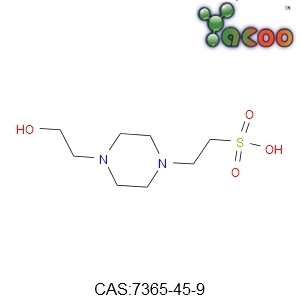In recent years, with the development of society, the intense life rhythm and bad eating habits have led to more and more people suffering from hyperuricemia, which has become a disease severely impairs human health. Epidemiological studies have shown that hyperuricemia is an important factor in the development of chronic diseases such as gout. Xanthine oxidase inhibitory peptide can significantly reduce the uric acid level in rats and serve the purpose of treating diseases. Buffer 4-(2-hydroxyethyl)-1-piperazineethanesulfonic acid (HEPES) could maximise the effect of xanthine oxidase inhibitory peptide.

Current treatment plan for hyperuricemia
At present, the treatment of hyperuricemia is mainly achieved by inhibiting the production of uric acid and promoting the excretion of uric acid. The representative drugs are: allopurinol and benzbromarone. However, existing drugs are generally not curable for hyperuricemia, and long-term use has serious side effects. Bioactive peptides are natural biomolecules that constitute the body and have almost no toxic side effects. Therefore, more and more bioactive peptides have been developed and utilized, especially antioxidant peptides and ACE inhibitory peptides. At present, the study of urate-lowering peptides mainly focuses on screening peptide chains with xanthine oxidase inhibitory activity. Studies have shown that some peptides have good xanthine oxidase inhibitory activity and can significantly reduce uric acid levels in hyperuricemia rats.
Since biomacromolecules usually have complex spatial structures, different environments have different conformations, and the biological activities of polypeptides are closely related to their spatial conformation. In the process of measuring the activity of the polypeptide, it is often necessary to select a suitable buffering reagent. Currently, the buffering agent selected is directly used the buffering reagent in the screening process of other xanthine oxidase inhibitors.
What is the responsibility of HEPES?

HEPES is a commonly used component of buffers in animal and human cell cultures. Studies have confirmed that HEPES has minimal cytotoxicity in all known buffers. The FDA has approved piperazine-based zwitterionic molecules as food additives. The study found that HEPES has a significant effect on enhancing the activity of the polypeptide xanthine oxidase inhibitor. Compared to the existing buffer system (TRIS-HCl), the xanthine inhibitory peptide has the best effect in the buffer system containing HEPES.
In addition, as a zwitterionic organic chemical buffering agent with an effective buffer range of 6.8~8.2, HEPES (CAS 7365-45-9) also can be used in a wide range of biochemical reactions, such as, in the research of organelles and highly denatured pH-sensitive proteins and enzymes, as well as biochemical diagnostic kit, DNA/RNA extraction kits and PCR diagnostic kit.
Reference
Su Guowan, He Weiwei, Zhao Mouming, et al. Application of HEPES (4-(2-hydroxyethyl)-1-piperazineethanesulfonic acid) in xanthine oxidase inhibitory peptide. 2018.01.09, CN107550909A.
Copyright © Suzhou Yacoo Science Co., Ltd. All Rights Reserved
Friendly Links :
online service